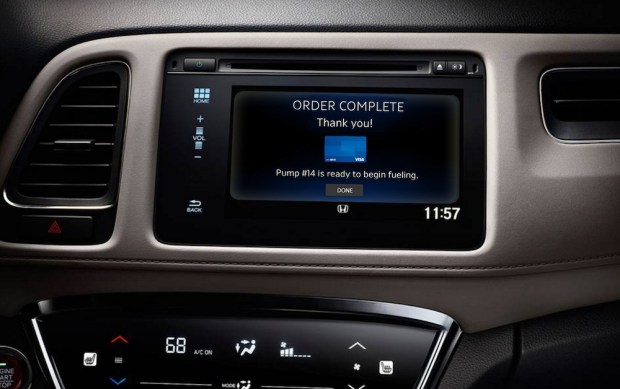Visa: What’s Driving Automotive’s Great Commerce Shift

The automotive world is on the precipice of a major change – a shifting of its gears, to use a fitting metaphor. And mostly because it doesn’t have a choice.
Travel back in time but a few years ago, and the buzz among automotive OEMs was whose ICE (internal combustion engine) was the biggest, the baddest and the most powerful.
Today, that bullet point is way down the list.
And all of the proof came last week, courtesy of CES. As Visa’s SVP of IoT, Avin Arumugam, remarked: OEMs are thinking much less about the mechanics of the car and much more about the software and services required to connect with other cars on the road and with stationary landmarks – about where and when they can and should drive themselves all or some of the time.
And, what is music to the ears of those in the payments and commerce community, how they can enable transactions in the cockpit that are both secure enough for the customer to feel safe and simple enough that they can be done while driving.
“A car is probably second only to a house in terms of consumer importance – emotionally and financially,” Arumugam told Karen Webster. “The OEMs are taking quite seriously their potential as a mobile, connected hub.”
Including for commerce.
According to The Digital Drive, 135 million car commuters account for an estimated $212 billion in commerce, using (mostly) smartphones to order ahead and pay for coffee, food and groceries and to find and pay for parking.
But that interest, the data also shows, remains underdeveloped. Twenty-one percent of those commuters who don’t engage in commerce today, would if the cockpit enabled in-vehicle payments – and 60 percent of those who do so today, would increase the frequency of those orders if in-vehicle payments were enabled.
“At CES this year, every booth we saw had a car in it – and those booths were surrounded by the OEMs,” Arumugam observed, adding that the Detroit Auto Show even took a back seat to the show of force around turning cars into connected devices.
What’s clear, though, is that automakers have an appetite for building cars that do things that no one has ever thought about asking cars to do before – and consumers have an appetite for buying them. About 17.3 million vehicles were sold to consumers in 2017, the seventh straight year of sales gains.
Visa, Arumugam said, wants to help power that transformation – not just by enabling cars to make digital payments, but also by using voice and visual biometrics that make commerce hands-free, and also authenticates the consumer the minute they slide into the driver’s seat and get behind the wheel.
Literally.
Building A Smooth Digital Journey
Visa’s role in the emerging world of in-vehicle commerce, Arumugam said, requires the integration of new consumer commerce demands and use cases, not the existing secure transaction environment that is the Visa Network. And, Arumugam noted, to anchor those experiences into behaviors that consumers are already doing in their cars.
For example, Arumugam noted, Visa’s partnership with Gentex Corp. makes in-vehicle driver authentication as easy as checking their rearview mirror and allowing it to scan their irises. The scan acts a biometric security mechanism – the car won’t start if the driver isn’t authorized. It also offers a more personalized driver experience, as the scan informs the car how to set the seat position, mirrors, steering wheel and driving playlist for whomever is sitting in the driver’s seat. It is also integrated with Visa Checkout, so when it’s time to make a purchase like gas, it can pre-authorize the transaction at a participating gas station operator.
In order to give consumers comfort that the transaction was completed, Visa will play its branded “chime” when a purchase is authorized. “It goes a long way to assure consumers in the car that checking their lipstick in the rearview mirror won’t trigger a purchase,” Arumugam joked.
The Near And Distant Future
Arumugam noted that his conversations with decades-long auto-industry veterans – now working at Visa – as well as those employed at the OEMs the company is working with, suggest that the very big shifts in thinking across the automotive industry are happening much faster than anything anyone has seen in the course of their career.
Arumugam attributes that change in mindset to the fact that today’s auto industry isn’t dealing with disruptive challenges from one direction, or even two, but four: the shift to electric engines from gas, the shift to connected cars, the shift to self-driving cars and the shift in models of car ownership in general.
“Whoever thought you would see an electric Porsche,” Arumugam remarked.
He said that these four big shifts all have “their own stepping stones and challenges” in a variety of ways – which means it is exceptionally hard to make predictions on exactly when changes are going to be made.
It’s also undeniable, he said, that the OEMs won’t do all they can to capitalize on this newfound opportunity, if for no other reason than to get an irresistible opportunity to connect directly as a brand to their customers – without the intermediary of the dealership standing in the way and, in many ways, shaping the perception of that brand to that customer.
Those connections will be made through commerce-enabled services, some of which will likely get their first real test drives in the world of commerce as soon as this year.
“I don’t think anyone knows exactly when these changeovers are happening, but I think it is actually a lot sooner than most people think,” Arumugam explained.